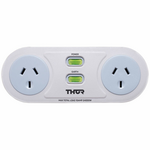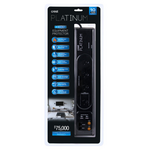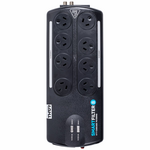
Surge Protection Buying Guide
What is a Surge Protector?
A surge protector is a device designed to protect your electrical devices from voltage spikes or "surges". The obvious function is that you can plug in multiple components into one power outlet, like a computer with all its different elements.
In a nutshell, it's a conduit between the power-point in your wall and your vulnerable electronic equipment.
As such, it should be a high-strength barrier against damaging power spikes and surges. It will let only a safe-amount of electricity through. A kind of technological gate-keeper, if you will. Well, a gate-keeper prepared to take a beating at the expense of everything else.
It often comes with multiple power sockets, so you can plug a few appliances at the one time - all sourcing power from the one power-point, albeit filtered through the surge protector.
So, are surge protectors essential and do you need them? The short answer; Yep, you need them.
What is a power surge?
A power surge is a sudden increase in voltage above the normal flow of electricity. When the increase lasts three nanoseconds (billionths of a second) or more, it's called a surge.
When it lasts for one or two nanoseconds, it's called a spike.
Do household appliances cause power surges?
Although it is commonly assumed only lighting strikes cause surges, the use of high-powered electrical devices within the home cause the majority of upsets to the voltage flow.
These devices need sudden high demands of electricity, which in turn distorts the power on the circuit. Sensitive equipment is therefore at risk on a daily basis. If not actually breaking the machine, it may put a strain on the components, thereby wearing them down over time.
And will the surge protector prevent damage from lightning?
Nothing man-made will prevent a direct lightning strike from causing damage. And the closer you are to a lightning strike, the more at risk you are. A surge protector will at least help minimise the damage caused.
The best prevention for damage during a storm is to unplug your appliances.
Why is Surge Protection now suddenly so important?
Sophisticated modern machinery, with digital components, is much more sensitive to power pollution and voltage fluctuations.
What should I look for in a Surge Protector?
1. What is the Joules Rating of the Surge Protector?
This is a prime indicator of how effective the Surge Protector will be against Spikes and Surges.
A typical surge protector is only able to absorb a finite amount of excess energy via its Metal Oxide Varistors (MOVs) - which dissipate this excess as heat.
The overall Joules rating is determined by the <strong>quality</strong> and <strong>quantity</strong> of MOVs. A good rule of thumb is that the higher the rating, the better the Surge Protector should be at dealing with spike and surge energy - and the longer the life-span potentially of the Surge Protector.
Appliances Online's range of Surge Protectors offers everything from good protection (around 500 Joules rating to awesome protection (getting up to 5000 Joules).
Note: Without a Joules Rating it's just a plain ol' power board and not offering any protection to your devices against spikes and surges.
2. What is the Clamping Voltage of the Surge Protector?
The clamping voltage is the maximum voltage allowed to pass by the surge protector through to the connected devices. In the event of a power surge, the Surge Protector (via its MOVs) clamps the voltage by redirecting it until the surge voltage drops sufficiently.
Lower is generally considered preferred. Clamping voltages are commonly between 300 and 500V. If you get any higher than this, you'll run the risk of damaging power levels being let through.
Some of them come with a clamping voltage lower than 300V.
How quickly does the Surge Protector react to a spike or surge?
Surge protectors won't act instantaneously - there's a slight lag. But the better protectors will act more quickly. We're talking a matter of nanoseconds here but it will make a difference. The very best surge protectors take less than one nanosecond.
4. What happens when the Surge Protector wears out?
Since all MOVs will inevitably fail after repeated surges, it's important to know what your Surge Protector will do once it wears out like this.
Look for surge protectors which have an Indicator Light that will tell you if the surge protectors are still working effectively.
Also, look for surge protectors with a built-in failsafe that will prevent the board from working as a powerboard if the surge protection fails. This will prevent any damaging power from going through to connected appliances.
So ... how much protection should I get?
An obvious way to approach Surge Protection is to consider how much you have at stake - if you have a lot of high-end components making up an amazing home theatre system, it's worth investing in a more expensive and (therefore) more effective surge protector.
On the other hand, if you're just looking for surge protection for a couple of inexpensive appliances, you may feel that you don't need to fork out quite so much.
If you have any questions, please feel free to contact our customer service team. Call us on 1300 000 500.



